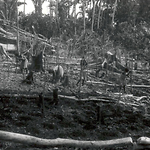Concept: Agriculture
Details
Shifting cultivation is the most common form of farming practiced in the Solomon Islands. After one or two crops are harvested, the gardener shifts to a new plot, leaving the old one fallow for years or even decades. Usually, everyone in a family helps make a garden, with men doing the initial heavy felling and clearing of trees with axes and machetes, leaving downed material to dry before it is burned and cleared. Before metal tools were available this was extremely arduous work and even with metal tools clearing heavily forested land was always difficult. Women do most of the planting and maintenance, with a digging stick the common planting tool. In the past, when yams and taro were more widely grown, men did more of the latter work than they do with sweet potato gardens, which now dominate. Indigenous crops include yams, taro, pana, sweet potatoes, bananas and sugarcane. Altars were once sometimes placed in garden plots to propitiate ancestral spirits for gardening success. Today, introduced plants like pineapples, potatoes, peanuts, cucumbers, watermelon, corn and tobacco are commonly grown. Many of the newer cultigens, and many newer varieties of old ones, first arrived in the nineteenth-century with labourers who brought them back from Fiji and Queensland.
